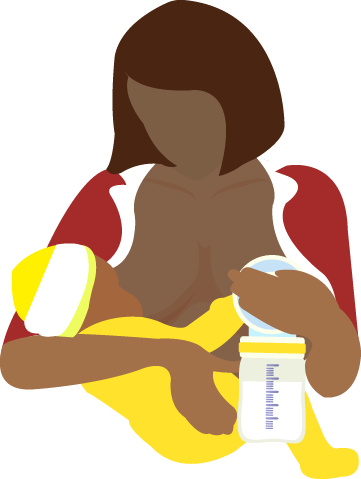
Teething is the process by which a baby’s teeth erupt, or break through, the gums. Teething generally occurs between 6 to 24 months of age.
Symptoms of teething include irritability, tender and swollen gums, and the infant wanting to place objects or fingers into the mouth in an attempt to reduce discomfort. Fever, cough, diarrhea, and cold symptoms are not found when a child is teething.
Oral over-the-counter pain relievers (acetaminophen [Tylenol] or ibuprofen [Children’s Advil/Motrin]) generally provide relief of symptoms.
Topical medications containing benzocaine may cause serious and potentially lethal side effects and should not be used to treat teething symptoms.
What Can I Do to Ease My Child’s Teething Pain?
Massage your child’s gums with a clean finger or the back of a small cold spoon.
Allow your child to bite down on a chilled (but never frozen) teething ring. A frozen teething ring can damage the gums.
Try an over-the-counter teething ointment to numb the gums. Ask your dentist or doctor for some product recommendations.
Allow your child to suck on a cold, wet cloth.
Learn more teething remedies »
What is teething?
Teething is the process by which an infant’s teeth erupt, or break through, the gums. Teething is also referred to as “cutting” of the teeth. Teething is medically termed odontiasis.
When do babies start teething?
The onset of teething symptoms typically precedes the eruption of a tooth by several days. While a baby’s first tooth can appear between 4 and 10 months of age, the first tooth usually erupts at approximately 6 months of age. Some dentists have noted a family pattern of “early,” “average,” or “late” teethers.
A relatively rare condition, “natal” teeth, describes the presence of a tooth on the day of birth. The incidence of such an event is one per 2,000-3,000 live births. Usually, this single and often somewhat malformed tooth is a unique event in an otherwise normal child. Rarely, the presence of a natal tooth is just one of several unusual physical findings which make up a syndrome. If the possibility of a syndrome exists, consultation with a pediatric dentist and/or geneticist can be helpful. The natal tooth is often loose and is commonly removed prior to the newborn’s hospital discharge to eliminate the risk of aspiration into the lungs.
What are the signs and symptoms of teething?
Teething is generally associated with gum and jaw discomfort as the infant’s tooth prepares to erupt through the gum surface. As the tooth moves beneath the surface of the gum tissue, the area may appear slightly red or swollen. Sometimes a fluid-filled area similar to a “blood blister” may be seen over the erupting tooth. Some teeth may be more sensitive than others when they erupt. The larger molars may cause more discomfort due to their larger surface area that can’t “slice” through the gum tissue as an erupting incisor is capable of doing. With the exception of the eruption of the third molars (wisdom teeth), eruption of permanent teeth rarely cause the discomfort associated with eruption of “baby” (primary or deciduous) teeth.
Teething may cause the following symptoms:
Increased drooling
Restless or decreased sleeping due to gum discomfort
Refusal of food due to soreness of the gum region
Fussiness that comes and goes
Bringing hands to the mouth
Mild rash around the mouth due to skin irritation secondary to excessive drooling
Rubbing the cheek or ear region as a consequence of referred pain during the eruption of the molars
Importantly, teething is not associated with the following symptoms:
Fever (especially over 101 F)
Diarrhea, runny nose, and cough
Prolonged fussiness
Rashes over the body
Can teething cause a fever?
Even though grandmothers may debate the findings, research has not shown a causal relationship between teething and development of a fever. Viral infections, which commonly occur independently simultaneous with dental eruptions, may product a fever. However, there is no teething virus.
Can teething cause vomiting?
The process of teething is not causally related to vomiting. As several pediatric dentists have noted, “Teething does not cause fever, runny nose, cough, or diarrhea. Teething causes teeth.”
What is the order of tooth eruption?
Share Your Story
The following is the general order of eruption of primary teeth:
Central incisors: 6-12 months of age
Lateral incisors: 9-16 months of age
Canine teeth: 16-23 months of age
First molars: 13-19 months of age
Second molars: 22-24 months of age
Between 6 to 12 years of age, the roots of these 20 “baby” teeth degenerate, allowing their replacement with 32 permanent “adult” teeth. The third molars (“wisdom teeth”) have no preceding “baby” version and generally erupt in mid to late adolescence. Because of their tendency to promote crowding and crooked orientation, they are often removed.
How long does teething last?
Children will commonly have variable discomfort during the few days before tooth eruption through the gum line. Some babies are bothered more than others during the migration through the tissues deep to the gum line. Because of their shape, molars are more likely to be associated with teething discomfort.
Source: MedicineNet
Link: https://www.medicinenet.com/teething/article.htm




